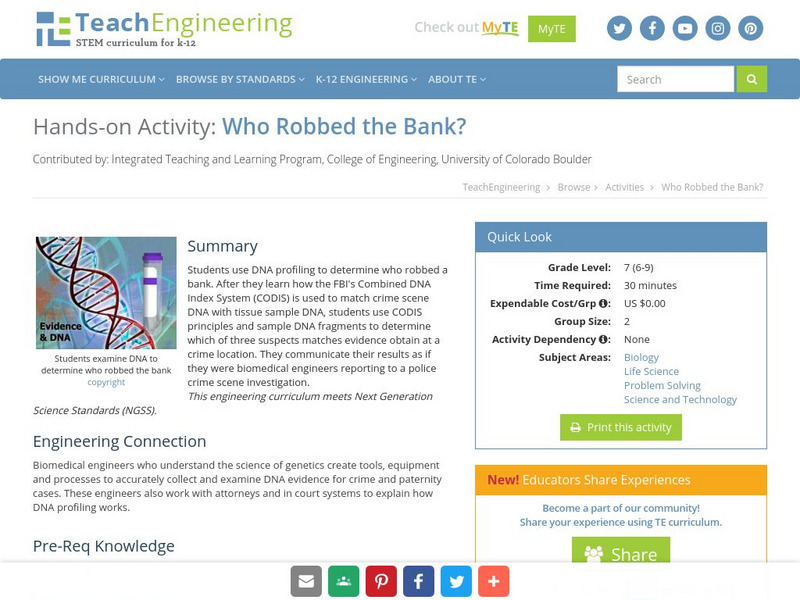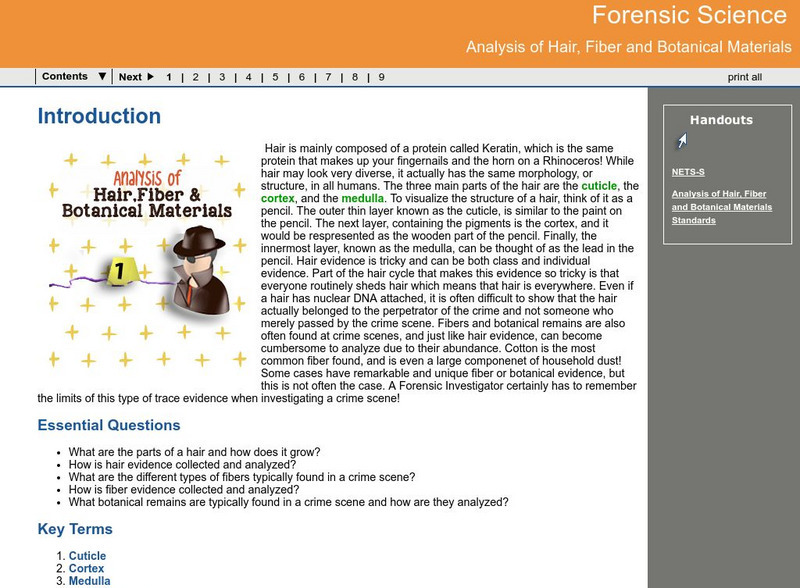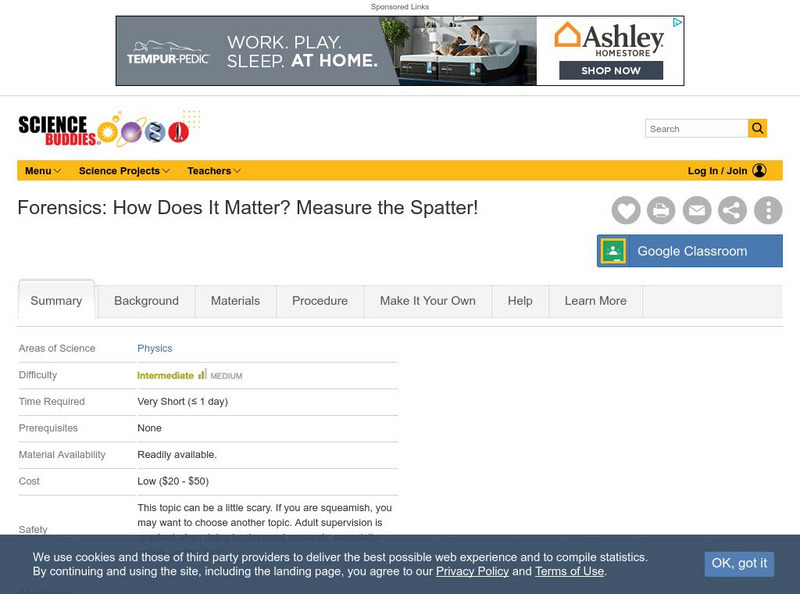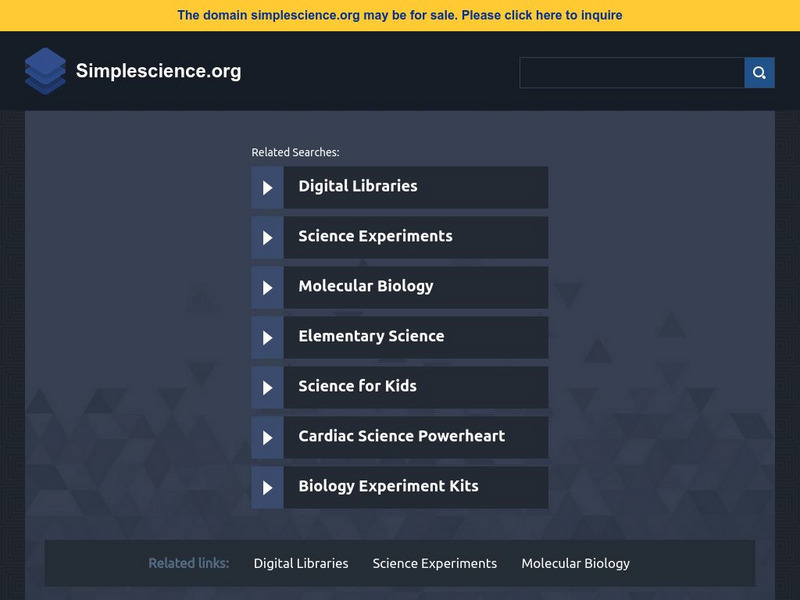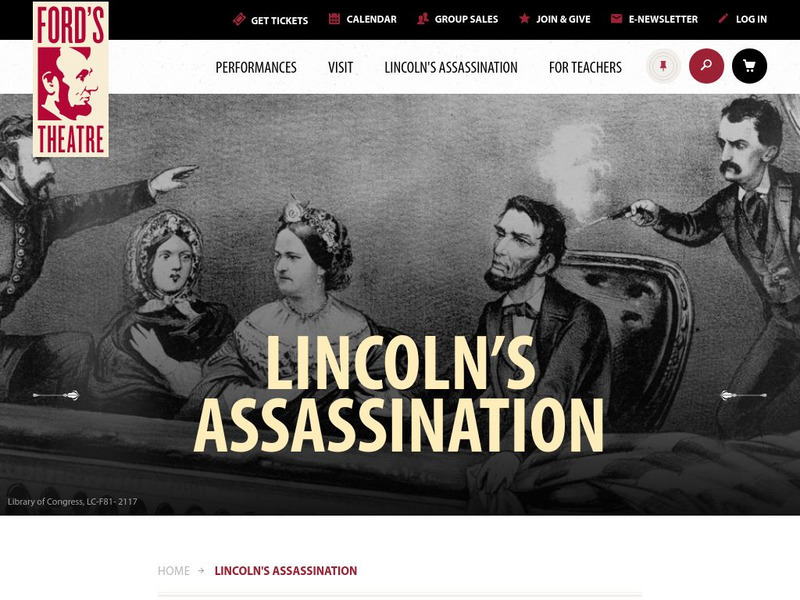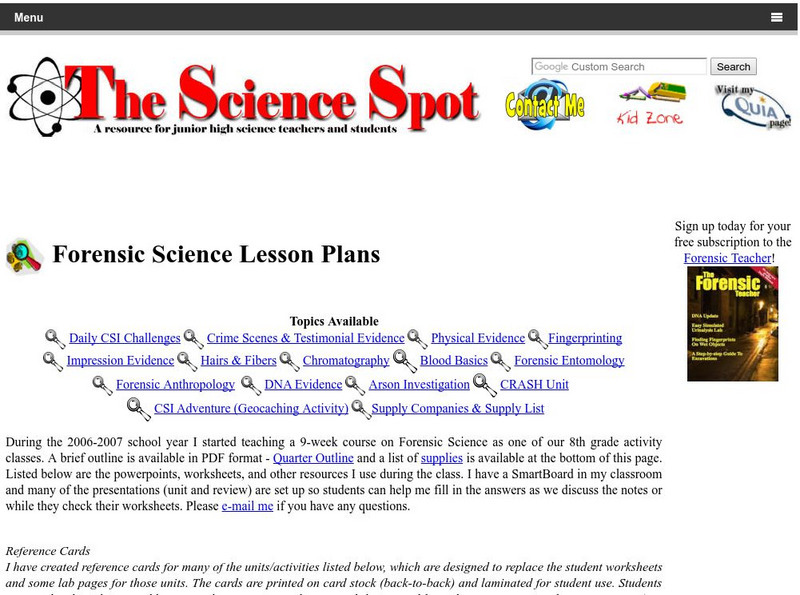Hi, what do you want to do?
Natural History Museum
Natural History Museum: On Maggots and Murders: Forensic Entomology [Pdf]
Five-page article explains how forensic scientists, when investigating crimes, analyze maggots and blowflies to determine approximate times of death.
National Health Museum
Access Excellence: Dna Detectives
A hands-on activity from Access Excellence for advanced biology classes. Students are given a crime scenario and three suspects. Their mission is to determine 'Who Dunnit?' by obtaining and analyzing DNA samples. Requires extensive...
TeachEngineering
Teach Engineering: Who Robbed the Bank?
Students use DNA profiling to determine who robbed a bank. After they learn how the FBI's Combined DNA Index System (CODIS) is used to match crime scene DNA with tissue sample DNA, students use CODIS principles and sample DNA fragments...
Georgia Department of Education
Ga Virtual Learning: Forensic Science: Analysis of Hair, Fiber and Botanical Mtl
This comprehensive interactive tutorial explores forensic science, particularly within the area of hair analysis. Investigate the parts of a hair and how it grows. Learn how is hair evidence is collected and analyzed and what different...
University of Missouri
Famous Trials: Illinois v. Nathan Leopold and Richard Loeb
Discover everything you would want to know about the Leopold & Loeb trial. This comprehensive tool provides an abundance of information including the evidence, the confession, the crime scene, the summations, the decision, photos,...
Science Buddies
Science Buddies: Forensics: How Does It Matter? Measure the Spatter!
Every criminal leaves behind evidence at the crime scene. The trick to catching the criminal is collecting all of the evidence and making sense of it. This is what the forensic expert does. In this science project you will be correlating...
Other
Simple Science: Cyber Sleuth
The interactive tutorial examines properties of digital images as they relate to forensic science. Learners classify and measure hair samples to determine the suspect most likely to have been at the crime scene. The resource has an...
Georgia Department of Education
Ga Virtual Learning: Forensic Entomology
In this comprehensive interactive tutorial you will investigate the area of entomology and how it applies to forensic science. Learn what information a forensic entomologist can determine from a crime scene and a victim's body. Other...
Other
Ford's Theatre: Lincoln's Assassination
Lincoln was assassinated at Ford's Theatre in full view of a packed audience. Many questions remain unanswered such as whether this was a lone act or part of a conspiracy. Conduct your own investigations using the features from this...
Curated OER
Exposition Display
Bertillon devised a system to make order out of the myriad of crime scene photos taken by the police. This brief site describes how that system worked and shows a number of crime scene photos taken from Bertillon's photo album.
Curated OER
Mob Hit in Restaurant, 1933.
National Public Radio tells the story of the traveling display of LAPD archived photos from crime scenes as early as the 1920s, some of them "Wonderfully cinematic."
Curated OER
Murder the Result of Various Injuries, 1898
In the 19th century, forensic pathologists began to use words and pictures to describe cadavers and to teach using cadavers in the classroom. See a number of interesting photos of various crime scenes on this interesting site.
Curated OER
Suicide by Cutting the Throat, 1898
In the 19th century, forensic pathologists began to use words and pictures to describe cadavers and to teach using cadavers in the classroom. See a number of interesting photos of various crime scenes on this interesting site.
Curated OER
Encircling Gunshot Wound in Brain, 1898
In the 19th century, forensic pathologists began to use words and pictures to describe cadavers and to teach using cadavers in the classroom. See a number of interesting photos of various crime scenes on this interesting site.
Curated OER
Suicide Through Stabbing, 1898
In the 19th century, forensic pathologists began to use words and pictures to describe cadavers and to teach using cadavers in the classroom. See a number of interesting photos of various crime scenes on this interesting site.
Curated OER
Head and Hand of a Drownee, 1864
In the 19th century, forensic pathologists began to use words and pictures to describe cadavers and to teach using cadavers in the classroom. See a number of interesting photos of various crime scenes on this interesting site.
Curated OER
Decomposed Stomach, 1864
In the 19th century, forensic pathologists began to use words and pictures to describe cadavers and to teach using cadavers in the classroom. See a number of interesting photos of various crime scenes on this interesting site.
Curated OER
Rope Marks and Upper Thigh, 1864
In the 19th century, forensic pathologists began to use words and pictures to describe cadavers and to teach using cadavers in the classroom. See a number of interesting photos of various crime scenes on this interesting site.
Curated OER
Murder the Result of Various Injuries, 1898
In the 19th century, forensic pathologists began to use words and pictures to describe cadavers and to teach using cadavers in the classroom. See a number of interesting photos of various crime scenes on this interesting site.
Chem4kids
Chem4 Kids: Chemistry Careers
Chem4Kids! looks at careers available in the large field of chemistry. Here you can explore the career of a doctor, pharmacist or pharmacologist, university researcher, forensics expert, or hazardous materials expert.
Science Buddies
Science Buddies: Who Done It? Dna Fingerprinting and Forensics
DNA fingerprinting (also known as DNA profile analysis and DNA typing), is a method of distinguishing between individuals by analyzing patterns in their DNA. This project focuses on the first method of DNA fingerprinting to be developed,...
Huntington Library
Huntington Library:garden Lesson Plans: Fruit Salad Hold the Dna, Please [Pdf]
After learning about DNA and how it is used in crime scene analysis, students take part in a lab activity where they extract DNA from ripened fruit.
Other
Science Spot: Forensic Science Lesson Plans
Huge collection of teacher-created lessons, activities, PowerPoint presentations, and worksheets for classes in forensic science.
Oak Ridge National Laboratory
Oak Ridge National Laboratory: Dna Forensics
A concise explanation of the use of DNA technologies in forensic identification from the Oak Ridge National Laboratory. Additional valuable resources are provided.
Other popular searches
- Crime Scene Investigator
- Crime Scene Scenarios
- Crime Scene Forensics
- Crime Scene Investigations
- Simulated Crime Scene
- Crime Scene Chromatography
- Recording the Crime Scene
- Crime Scene Analysis
- Crime Scene Investigate
- Forensics Dna Crime Scene
- Crime Scene Acidity
- Mock Crime Scenes





![Natural History Museum: On Maggots and Murders: Forensic Entomology [Pdf] Website Natural History Museum: On Maggots and Murders: Forensic Entomology [Pdf] Website](https://static.lp.lexp.cloud/images/attachment_defaults/resource/large/FPO-knovation.png)
